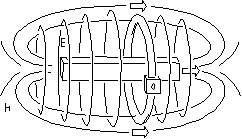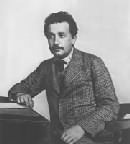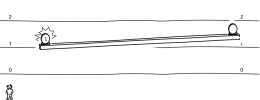|
John
D. Norton
History of Special Relativity and
Einstein's Work of 1905
|
|
home >> research >> history of special
relativity |
 |
A very great deal has been written about Einstein's discovery of
the special theory of relativity. My goal in this work is to draw
attention back to what was most important in the discovery, that it
emerged from Einstein's sustained reflections on problems in
electrodynamics. Once Maxwell's electrodynamics was in place, little
could stop something like special relativity emerging. Until that
electrodynamics was in place, no examination of clocks, their
synchronization, agonies over what it really means to be
simultaneous, and so on, could properly lead to special relativity.
|
"Einstein's Investigations of Galilean Covariant
Electrodynamics prior to 1905," Archive for History of Exact
Sciences, 59 (2004), pp. 45-105. Download
"Einstein's Special Theory of Relativity and the Problems in the
Electrodynamics of Moving Bodies that Led him to it." pp. 72-102 in Cambridge
Companion to Einstein, M. Janssen and C. Lehner, eds., Cambridge
University Press, 2014. Download.
|
 |
Writing decades later in his Autobiographical Notes,
Einstein recalled how his discovery of special relativity in 1905 was
decisively furthered by his reading of the philosophical writings of
Hume and Mach. Einstein's remark is intriguing and maddeningly brief.
I try to pin down precisely what Einstein found so useful in the
writings of Hume and Mach. I suggest that it was not a particular
view of space and time but a theory of concepts.
|
"How Hume and Mach Helped Einstein Find Special Relativity,"
pp. 359-386 in M. Dickson and M. Domski, eds., Discourse on a New Method:
Reinvigorating the Marriage of History and Philosophy of Science. Chicago and La Salle, IL: Open Court, 2010. Download |
 |
Einstein reported the importance to his discovery of special
relativity of a famous thought experiment in which he chased a beam
light and could thereby observe frozen light. This thought experiment
is quite unlike others by Einstein since it is not clear why
observing frozen light would be problematic. I suggest that the
thought experiment recovers its cogency if we read it as an objection
to an emission theory of light.
|
"Chasing the Light: Einstein's Most Famous Thought
Experiment," prepared for Thought Experiments in Philosophy, Science and
the Arts, eds., James Robert Brown, Mélanie Frappier and Letitia
Meynell, Routledge. Download.
See also"Chasing the Light: Einstein's Most Famous
Thought Experiment" in Goodies. |
 |
The final breakthrough for special relativity came some 5 to 6
weeks prior to the completion of the special relativity paper of 1905
when Einstein hit upon the relativity of simultaneity, a moment he
called "The Step." Our default assumption is that he hit upon this
result by reflecting on clocks and how we synchronize them with light
signals. I suggest that we have no direct evidence for this
assumption and that a more plausible pathway has him reading the
result off the observation of stellar aberration and Fizeau's
measurment of the speed of light in moving water.
|
See "Discovering the Relativity of Simultaneity: How
did Einstein take "The Step"?" in Goodies or download as pdf. |
 |
In 1905, Einstein urged that high frequency light carries the
distinctive signature of discreteness, so that its energy is
distributed in spatially localized light quanta. The methods Einstein
used to arrive at this startling result appear also in his other work
of 1905 on Brownian motion and sugar solutions. There he routinely
exploited the idea that the macroscopic, thermal properties of
systems like ideal gases and dilute solutions carry a distinctive
signature of atomic discreteness. |
Latest simplified account: "Einstein's Miraculous Argument of 1905: The Thermodynamic Grounding of Light Quanta" Download.
"Atoms, Entropy, Quanta: Einstein's Miraculous
Argument of 1905," Studies in History and Philosophy of Modern
Physics, 37 (2006), pp. 71-100. Download
and
"Atoms Entropy
Quanta: Einstein's Statistical Physics of 1905" in Goodies. |
|
In 2005 I spoke in several national and international conferences
that celebrate Einstein's annus mirabilis of 1905.
|
Schedule and links
to streaming
video of two talks given in Bern, Switzerland. |
 |
Our urge to oversimplify has led to many myths about what powered Einstein's discoveries. Naive thinking? Capricious rule-breaking? Operational thinking? I correct some myths and try to give a more accurate picture of how Einstein made two discoveries: special relativity and the light quantum. |
""How Einstein Did Not Discover," Physics in Perspective, 18 (2016), pp. 249-282.
Download.
|
|
|




